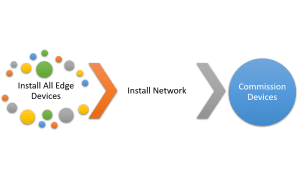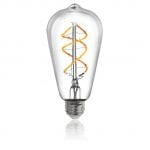Networked Controls 101: Top 5 Deployment Challenges
Today’s IoT connected lighting systems are advancing in sophistication and complexity at an ever-quickening rates, making it a challenge to keep up with the latest and greatest technologies. Couple that with the common challenges of deploying a networked controls system and it’s no wonder that many installation professionals are still leery in spec’ing an advanced IoT connected lighting solution.
In this week’s post we’ll take a dive into the top five deployment challenges of a networked controls solution and offer up some tips on how to overcome these common challenges.
Let’s get to it.
Deployment Challenge #1: Choosing the “right” controls solutions
When it comes to matching the “right” networked controls technology with the “right” application it’s easy to get lost in the weeds. Just do a quick search online for connected controls and you’ll find a litany of folks pronouncing their technology is the “right” technology for your application…ZigBee, Bluetooth, WiFi, EnOcean, you name it and there is someone out there saying it’s better than all the rest.
So how do you choose the “right” networked controls solution? The first step is to get a little background on the most applicable technologies currently on offer. Here are some cliff notes on some of the most common wireless networked controls protocols currently on offer:
- ZigBee Mesh: This wireless protocol is established by the IEEE standards board and was designed to be a low power, low data rate, wireless mesh network. The main benefits of ZigBee is it’s inexpensive price point and low power features, making it ideal for energy efficiency applications. ZigBee also that include enhanced security with 128-bit encryption. Learn more about ZigBee and the IEEE [https://www.zigbee.org/zigbee-for-developers/about-us/]
- Bluetooth Mesh: Without getting too far into the weeds, Bluetooth mesh networking uses a managed flood approach for message transmission. In other words, you can send more data faster and without the need of a network gateway. Think of streaming music from your phone to a Bluetooth speaker. Lots of data sent quickly and without the need of any kind of router in-between. Learn more about Bluetooth Mesh. [https://blog.bluetooth.com/introducing-bluetooth-mesh-networking]
- EnOcean: This innovative technology standard uses energy harvesting to power sensors and switches, thereby allowing them to operate without batteries or any other wired connection. Learn more about EnOcean [https://www.enocean.com/en/]
- Wi-Fi: While Wi-Fi has the largest capacity of data transfer capability, it is often much more expensive as compared to other technologies and tends to consume much more power; not ideal for energy efficiency applications. Learn more about Wi-Fi standards [https://www.networkworld.com/article/3238664/wi-fi/80211-wi-fi-standards-and-speeds-explained.html]
Deployment Challenge #2: Designing systems for optimal performance
Now you’ve chosen the most applicable networked controls solution for the application at hand, but that’s only half the battle. Designing a networked controls system that is not only functional but will perform at peak performance is typically easier said than done….and if you’ve taken a hand at designing a networked controls system you know this all too well. These systems are a far cry from a simply wire up and go. The last thing any trade professional wants is to install a system to only find out post construction that it’s not performing as the end-user was told it would – no one likes getting egg on their face in front of a client.
Here are some behind-the-scenes tips to ensure a system is designed to match its performance intent:
- Controls Narrative: Have a conversation with the client to better understand how they need/would like the system to operate. Based on their needs you can develop what’s called a controls narrative that spells out the types of control profiles you’ll need to create within the system.
- Granular or Zonal: Next, using the controls narrative you created you can then determine if the system should be a granular system (i.e. a system where every luminaire has a control node) or zonal (where control nodes are placed on lighting circuits versus on each individual luminaire).
- Edge Device Functionality: Based on the controls narrative and system style (granular/zonal) you’ll next want to determine if there are any special requirements for edge devices. This could include whether sensors need to be placed in particular locations within a room to avoid false-positives, etc.
- Network Backbone: Lastly, using all the above information that you’ve fleshed out you’ll now determine what kind of network backbone the system will require. Will it need access to the client’s network or utilize cellular modems to talk to the outside world, or will it simply be a standalone on-premise network?
Deployment Challenge #3: Defining correct sequence of component installation
Having a properly designed system is great and all, but if the correct sequence of component installation isn’t established then that wonderful design will have been created in vein. Why? Well, when it comes down to installing a networked controls system process is everything. Many times, if certain devices aren’t installed and operational first the more challenging the commissioning process will be – resulting in more time on site, troubleshooting, and system reconfigurations. All the things an installer would ideally like to avoid.
Depending on the networked control technology that’s being installed the sequence of component installation may vary, but the below tips will help you in determining how to frame the right sequence from the get-go:
- Does the system require access to client’s network?
- Is there a system gateway?
- Are the edge devices going to be factory-installed or field-installed?
Depending on your answers to the above questions your sequence of component installation may vary (see example below)
Coordinate with Client IT
Install Network Backbone
Install Gateways/Ensure operational
Install edge devices (i.e. sensors, switches, fixture adapters, etc.)
Commission Devices.
Deployment Challenge #4: Commissioning system devices
Now comes the most fun part of all: Commissioning. If you’re an installer and have experienced installing a networked controls system to only learn that after installation it’s actually your responsibility to commission the system too, well you know first-hand the headaches that commissioning a system can give you. It’s all about process – no matter the technology. Building a plan to get from point A to point B then point B to point C is at the heart of overcoming system commissioning challenges.
Here is an example of a poorly planned commissioning process:
Deployment Challenge #5: Technical support calls
That’s it. You’ve finished the installation of the new networked control system, commissioned it as best you could and your job is done, right? Eh, not so fast. Again, if you’ve taken a hand at deploying a networked controls system you know better than anyone that your phone will ring with an end user on the other end of the line seeking system support.
To help mitigate these often-strenuous technical support call requests, here are a few tips to get you set up properly:
- Documenting the types of control profiles setup and what they’re designed to do and where they were applied.
- Filing a digital floor plans to easily locate system areas when a call comes in.
- Listing out an FAQ of common system questions and have it handy for reference
- How do I lower my lights?
- Why won’t my office lights turn on?
- Why can’t I log into the system?
- How do I change/create a new control profile?
- Perform a hands-on end user training with key stakeholders to show them how to use the system and answer any questions.
- Keep a log of all support call requests to help identify common problems that you can later refer to manufacturer and further develop you FAQ sheet.






Recent Comments